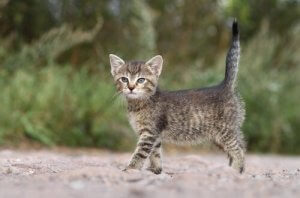6 Fascinating Facts About your Cat's Paws

Cute, squishy and incredibly soft (until they unsheathe their claws that is), a cat’s paws are one of its most remarkable features. So, in this article, we want to tell you some fascinating facts about your cat’s paws.
Fascinating facts about your cat’s paws
A cat’s paws aren’t just for walking- they also use them for fighting, climbing (from trees, to sofas, and occasionally our legs…) and even for communication. Here are some of the most interesting things you should know about your cat’s paws:
1. They walk on tip-toe
No one can deny that a cat has one of the most elegant and stylish walks in the animal kingdom. They seem to float across the room, their paws barely touching the ground. It is this unique walk that allows them to move so silently. This is because cats – like all felines – are digitigrades, meaning that instead of walking on their soles and heels as humans do, they actually walk on their toes.

While this might be uncomfortable for us, it is completely normal for our feline friends. Their feet are perfectly designed for it; the size and softness of their pads allow them to move easily on tip-toe, like miniature, fluffy ballerinas.
2. The number of toes can vary
A cat’s front and back paws are very different. Look closely, you’ll notice that the front paws have five toes, while the back paws have only four. Both front and back paws have claws which they can sheathe and unsheathe at will.
This mechanism relies on a ligament which connects the two distal bones of the toe. These, in turn, are connected to the digital flexor tendon. Normally, a cat’s claws are hidden beneath its fur. However, when it wants to extend them, the tendon contracts, and the distal bones push the claws forward.
3. Paw pads: soft, but incredibly tough
One of the most notable features of a cat’s paws is its wonderfully soft pads. You could be forgiven for thinking that such delicate skin would leave your cat vulnerable to splinters, cuts and other injuries. In fact, these pads are tough enough to protect the paws from most external dangers, from sharp objects, to extremes of temperature.
Plus, paw pads are highly sensitive, allowing cats to hunt more efficiently. Thanks to their pads, cats can assess the health, energy, location and texture of their prey. They also allow them to gauge whether something is too hot or too cold.
4. Cats sweat through their paws
The majority of a cat’s sweat glands are located on the pads of its paws, so it is here that they produce the most sweat. These sweat glands also allow them to leave traces of their scent behind as they walk. Leaving their scent allows them to mark their territory, informing other cats that they are there, and that that territory belongs to them.

These glands allow cats to communicate with one another. If, for example, your cat scratches a scratching post or sofa, or “kneads” its bed, it’s because it wants to leave its scent behind, claiming that object as its own.
5. Their paw pads are the same color as their skin
The pigment that determines the color of your cat’s skin is also responsible for the color of their paw pads. If you look carefully, you’ll notice that their pads are exactly the same color as the skin beneath their fur. As such, they can be a variety of different colors: gray, ginger, black, white, pink… It all depends on the pigmentation of their skin.
6. They wash them constantly
As you probably already know, cats are one of the cleanest creatures in the animal kingdom. They are obsessed with washing and grooming themselves, especially when it comes to their paws. Every object, substance and germ that gets onto their paws will eventually end up in their mouths, and in turn, their stomachs.
As a result, they need to be very careful about where they put their feet. Plants, chemical residue, dirt… There are many substances that can be harmful to your pet.
Cute, squishy and incredibly soft (until they unsheathe their claws that is), a cat’s paws are one of its most remarkable features. So, in this article, we want to tell you some fascinating facts about your cat’s paws.
Fascinating facts about your cat’s paws
A cat’s paws aren’t just for walking- they also use them for fighting, climbing (from trees, to sofas, and occasionally our legs…) and even for communication. Here are some of the most interesting things you should know about your cat’s paws:
1. They walk on tip-toe
No one can deny that a cat has one of the most elegant and stylish walks in the animal kingdom. They seem to float across the room, their paws barely touching the ground. It is this unique walk that allows them to move so silently. This is because cats – like all felines – are digitigrades, meaning that instead of walking on their soles and heels as humans do, they actually walk on their toes.

While this might be uncomfortable for us, it is completely normal for our feline friends. Their feet are perfectly designed for it; the size and softness of their pads allow them to move easily on tip-toe, like miniature, fluffy ballerinas.
2. The number of toes can vary
A cat’s front and back paws are very different. Look closely, you’ll notice that the front paws have five toes, while the back paws have only four. Both front and back paws have claws which they can sheathe and unsheathe at will.
This mechanism relies on a ligament which connects the two distal bones of the toe. These, in turn, are connected to the digital flexor tendon. Normally, a cat’s claws are hidden beneath its fur. However, when it wants to extend them, the tendon contracts, and the distal bones push the claws forward.
3. Paw pads: soft, but incredibly tough
One of the most notable features of a cat’s paws is its wonderfully soft pads. You could be forgiven for thinking that such delicate skin would leave your cat vulnerable to splinters, cuts and other injuries. In fact, these pads are tough enough to protect the paws from most external dangers, from sharp objects, to extremes of temperature.
Plus, paw pads are highly sensitive, allowing cats to hunt more efficiently. Thanks to their pads, cats can assess the health, energy, location and texture of their prey. They also allow them to gauge whether something is too hot or too cold.
4. Cats sweat through their paws
The majority of a cat’s sweat glands are located on the pads of its paws, so it is here that they produce the most sweat. These sweat glands also allow them to leave traces of their scent behind as they walk. Leaving their scent allows them to mark their territory, informing other cats that they are there, and that that territory belongs to them.

These glands allow cats to communicate with one another. If, for example, your cat scratches a scratching post or sofa, or “kneads” its bed, it’s because it wants to leave its scent behind, claiming that object as its own.
5. Their paw pads are the same color as their skin
The pigment that determines the color of your cat’s skin is also responsible for the color of their paw pads. If you look carefully, you’ll notice that their pads are exactly the same color as the skin beneath their fur. As such, they can be a variety of different colors: gray, ginger, black, white, pink… It all depends on the pigmentation of their skin.
6. They wash them constantly
As you probably already know, cats are one of the cleanest creatures in the animal kingdom. They are obsessed with washing and grooming themselves, especially when it comes to their paws. Every object, substance and germ that gets onto their paws will eventually end up in their mouths, and in turn, their stomachs.
As a result, they need to be very careful about where they put their feet. Plants, chemical residue, dirt… There are many substances that can be harmful to your pet.
This text is provided for informational purposes only and does not replace consultation with a professional. If in doubt, consult your specialist.








